
Johann Franz Reichsritter von Schönau-Zell (1619–1656) was the Prince-Bishop of Basel from 1651 to 1656.

The Diocese of Basel is a Roman Catholic diocese in Switzerland.

Johann Franz Reichsritter von Schönau-Zell (1619–1656) was the Prince-Bishop of Basel from 1651 to 1656.

The Diocese of Basel is a Roman Catholic diocese in Switzerland.
Johann Franz von Schönau-Zell was born in Ensisheim on 15 July 1619, the son of Marx Jakob von Schönau and of Margaretha von Reinach. [1] He spent his childhood in Waldshut after his father became bailiff of the forest there. His father set on a career in the clergy for his younger son. [1] The boy studied at Porrentruy, the University of Freiburg, Lucerne, and at the Collegium Germanicum in Rome. [1]

Ensisheim is a commune in the Haut-Rhin department in Grand Est in north-eastern France. It is also the birthplace of the composer Léon Boëllmann. The Germanic origins of the village's name reflects the area's history.
Waldshut is a Landkreis (district) in the south of Baden-Württemberg, Germany. Neighbouring districts are Lörrach, Breisgau-Hochschwarzwald and Schwarzwald-Baar; followed in the south by the Swiss cantons of Schaffhausen, Zürich and Aargau.

Porrentruy is a Swiss municipality and seat of the district of the same name located in the canton of Jura.
He was ordained as a priest on 15 April 1648. [2] On 18 September 1648 the cathedral chapter of Basel Münster elected him to be Prince-Bishop of Basel. [2] Pope Innocent X confirmed the appointment on 3 March 1653. [2] Thomas Henrici, auxiliary bishop of Basel on 15 June 1653. [2]
According to both Anglican and Catholic canon law, a cathedral chapter is a college of clerics (chapter) formed to advise a bishop and, in the case of a vacancy of the episcopal see in some countries, to govern the diocese during the vacancy. These chapters are made up of canons and other officers, while in the Church of England chapters now includes a number of lay appointees; in the Roman Catholic Church their creation is the purview of the pope. They can be "numbered", in which case they are provided with a fixed "prebend", or "unnumbered", in which case the bishop indicates the number of canons according to the rents. In some Church of England cathedrals there are two such bodies, the lesser and greater chapters, which have different functions. The smaller body usually consists of the residentiary members and is included in the larger one.

Pope Innocent X, born Giovanni Battista Pamphilj, was Pope from 15 September 1644 to his death in 1655.

An auxiliary bishop is a bishop assigned to assist the diocesan bishop in meeting the pastoral and administrative needs of the diocese. Auxiliary bishops can also be titular bishops of sees that no longer exist.
He died in Porrentruy on 30 November 1656. [1] He received heart-burial. [1]
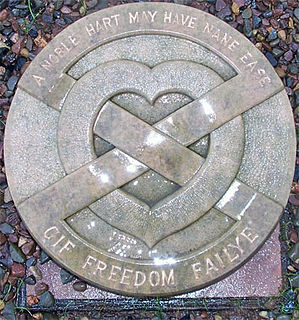
Heart-burial is a type of burial in which the heart is interred apart from the body. This is a very ancient practice, and the special reverence shown towards the heart is doubtless due to its early association with the soul, affections, courage and conscience of man.

Karl Eusebius, Prince of Liechtenstein was the Prince of Liechtenstein. He inherited this title in 1627 from his father Karl I. He was 16 and thus considered underage, and his uncles Prince Gundakar and Maximillian acted as regents until 1632. From 1639 to 1641 Karl was Chief Captain of High and Low Silesia.

Jean-Baptiste-Joseph Gobel was a French Catholic cleric and politician of the Revolution. He was executed during the Reign of Terror.

Zell im Wiesental is a town in the district of Lörrach in Baden-Württemberg, Germany. It is situated in the Black Forest, on the river Wiese, 26 km northeast of Basel, and 32 km south of Freiburg.

Basel was a canton of Switzerland that was in existence between 1501 and 1833, when it was split into the two half-cantons of Basel-City and Basel-Country.
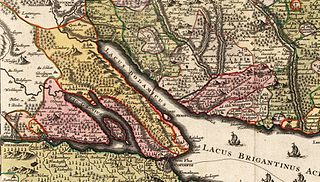
The Bishopric of Constance, or Prince-Bishopric of Constance, was a Prince-Bishopric and Imperial Estate of the Holy Roman Empire from the mid–12th century until its secularisation in 1802–1803. The much larger Roman Catholic Diocese of Konstanz existed from about 585 until its dissolution in 1821. It belonged to the ecclesiastical province of Mainz since 780/782.

The Prince-Bishopric of Osnabrück) (German: Hochstift Osnabrück; Fürtsbistum Osnabrück was a state of the Holy Roman Empire from 1225 until 1803. It should not be confused with the Diocese of Osnabrück, which was larger and over which the prince-bishop exercised only the spiritual authority of an ordinary bishop. It was named after its capital, Osnabrück.

The Prince-Bishopric of Bamberg was an ecclesiastical State of the Holy Roman Empire. It goes back to the Roman Catholic Diocese of Bamberg established at the 1007 synod in Frankfurt, at the behest of King Henry II to further expand the spread of Christianity in the Franconian lands. The bishops obtained the status of Imperial immediacy about 1245 and ruled their estates as Prince-bishops until they were subsumed to the Electorate of Bavaria in the course of the German Mediatisation in 1802.

Metternich is a German noble family originating in the Rhineland. The most prominent member was Prince Klemens von Metternich, who was the dominant figure at the Congress of Vienna (1814–1815). The family belonged to the high nobility.
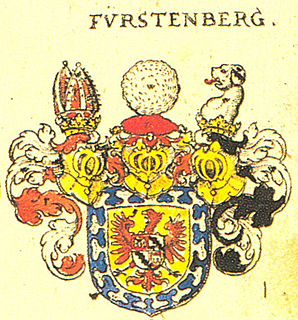
Egon VIII of Fürstenberg-Heiligenberg was Imperial Count of Fürstenberg-Heiligenberg (1618–1635) and Bavarian Field-marshal, and an important military leader in the Thirty Years' War.
Johann Konrad von Roggenbach (1618–1693) was the Prince-Bishop of Basel from 1656 to 1693.
Wilhelm Jakob Rink von Baldenstein (1624–1705) was the Prince-Bishop of Basel from 1693 to 1705.

Johann Konrad von Reinach-Hirtzbach (1657–1737) was the Prince-Bishop of Basel from 1705 to 1737.
Jakob Sigismund von Reinach-Steinbrunn (1683–1743) was the Prince-Bishop of Basel from 1737 to 1743.
Simon Nikolaus Euseb Reichsgraf von Montjoye-Hirsingen (1693–1775) was the Prince-Bishop of Basel from 1762 to 1775.

Franz Joseph Sigismund von Roggenbach (1726–1794) was the Prince-Bishop of Basel from 1782 to 1794.
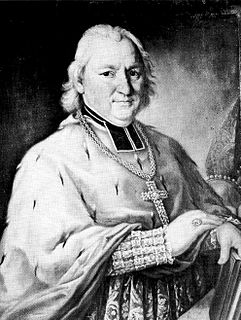
Franz Xaver Freiherr von Neveu (1749–1828) was the last Prince-Bishop of Basel, reigning from 1794 to 1803. After the Prince-Bishopric of Basel was mediatised to the Margraviate of Baden in 1803, Neveu remained Bishop of Basel, though without exercising temporal power, until his death in 1828.
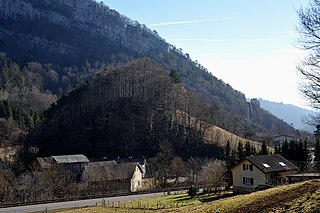
Péry-La Heutte is a municipality in the Jura bernois administrative district in the canton of Bern in Switzerland. It is located in the French-speaking Bernese Jura. On 1 January 2015 the former municipalities of Péry and La Heutte merged to form the new municipality of Péry-La Heutte.

Jean de Vienne was a Burgundian nobleman, prelate and prince of the Holy Roman Empire. He served as the archbishop of Besançon from 1355 until his transfer to the diocese of Metz in 1361. He was transferred to the prince-bishopric of Basel in 1365. In all three dioceses, he was unable to live peacefully with the townspeople, finally resulting in open warfare in Basel. In each of his bishoprics he was the third bishop of his name, Jean III.
| Catholic Church titles | ||
|---|---|---|
| Preceded by Beat Albrecht von Ramstein | Prince-Bishop of Basel 1653–1656 | Succeeded by Johann Konrad von Roggenbach |
| This article about a Catholic bishop from Europe is a stub. You can help Wikipedia by expanding it. |